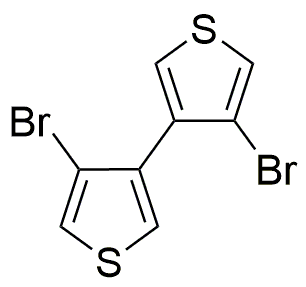4,4'-Dibromo-3,3'-bithiophene is widely utilized in research focused on:
- Organic Electronics: This compound is a key material in the development of organic semiconductors, particularly in organic photovoltaic cells and organic light-emitting diodes (OLEDs). Its unique electronic properties enhance device efficiency.
- Conductive Polymers: It serves as a building block for synthesizing conductive polymers, which are essential in various applications such as flexible electronics and sensors, offering advantages over traditional materials due to their lightweight and flexibility.
- Material Science: The compound is used in the creation of advanced materials with tailored properties, such as improved thermal stability and conductivity, making it valuable in the development of high-performance coatings and composites.
- Research in Photonics: Its properties are leveraged in photonic applications, including waveguides and lasers, where its ability to manipulate light can lead to innovations in communication technologies.
- Environmental Sensors: The compound is explored for use in sensors that detect environmental pollutants, providing a means for real-time monitoring and contributing to sustainability efforts.
General Information
Properties
Safety and Regulations
Applications
4,4'-Dibromo-3,3'-bithiophene is widely utilized in research focused on:
- Organic Electronics: This compound is a key material in the development of organic semiconductors, particularly in organic photovoltaic cells and organic light-emitting diodes (OLEDs). Its unique electronic properties enhance device efficiency.
- Conductive Polymers: It serves as a building block for synthesizing conductive polymers, which are essential in various applications such as flexible electronics and sensors, offering advantages over traditional materials due to their lightweight and flexibility.
- Material Science: The compound is used in the creation of advanced materials with tailored properties, such as improved thermal stability and conductivity, making it valuable in the development of high-performance coatings and composites.
- Research in Photonics: Its properties are leveraged in photonic applications, including waveguides and lasers, where its ability to manipulate light can lead to innovations in communication technologies.
- Environmental Sensors: The compound is explored for use in sensors that detect environmental pollutants, providing a means for real-time monitoring and contributing to sustainability efforts.
Documents
Safety Data Sheets (SDS)
The SDS provides comprehensive safety information on handling, storage, and disposal of the product.
Product Specification (PS)
The PS provides a comprehensive breakdown of the product’s properties, including chemical composition, physical state, purity, and storage requirements. It also details acceptable quality ranges and the product's intended applications.
Certificates of Analysis (COA)
Search for Certificates of Analysis (COA) by entering the products Lot Number. Lot and Batch Numbers can be found on a product’s label following the words ‘Lot’ or ‘Batch’.
*Catalog Number
*Lot Number
Certificates Of Origin (COO)
This COO confirms the country where the product was manufactured, and also details the materials and components used in it and whether it is derived from natural, synthetic, or other specific sources. This certificate may be required for customs, trade, and regulatory compliance.
*Catalog Number
*Lot Number
Safety Data Sheets (SDS)
The SDS provides comprehensive safety information on handling, storage, and disposal of the product.
DownloadProduct Specification (PS)
The PS provides a comprehensive breakdown of the product’s properties, including chemical composition, physical state, purity, and storage requirements. It also details acceptable quality ranges and the product's intended applications.
DownloadCertificates of Analysis (COA)
Search for Certificates of Analysis (COA) by entering the products Lot Number. Lot and Batch Numbers can be found on a product’s label following the words ‘Lot’ or ‘Batch’.
*Catalog Number
*Lot Number
Certificates Of Origin (COO)
This COO confirms the country where the product was manufactured, and also details the materials and components used in it and whether it is derived from natural, synthetic, or other specific sources. This certificate may be required for customs, trade, and regulatory compliance.


